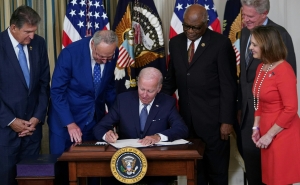New Industry Documents Highlight Role of Pharmacies in Driving Opioid Epidemic
Archive’s latest release of litigation records illustrates pharmacies’ repeated failure to heed warning signs and safety guidelines

Johns Hopkins University and the University of California, San Francisco (UCSF), have added new documents to the Opioid Industry Documents Archive that detail the role of retail pharmacies in the opioid overdose epidemic.
The documents, based on litigation led by the Florida Attorney General, the Ohio counties of Lake and Trumbull, and the San Francisco City Attorney, show how companies including CVS, Rite-Aid, Target, Walgreens and Walmart repeatedly failed to employ safeguards meant to prevent the over-dispensing and diversion of potentially dangerous controlled substances.
The court records show that pharmacies repeatedly ignored the Drug Enforcement Administration’s (DEA) strict policies and guidelines designed to protect patients who receive controlled substances like prescription opioids. Also, the records show that many of these pharmacies repeatedly faced disciplinary action for failing to take corrective steps after breaking the rules. Examples include:
- Not following DEA guidelines on drug dispensing
- Failing to report suspicious drug sales to the DEA
- Not having (or not following) a plan to prevent the illegal diversion of drugs
- In the case of Walgreens, engaging in deceptive marketing by not informing patients about the dangers of opioids
The archive, launched by the two research universities in March 2021, is a digital repository of publicly disclosed documents arising from litigation brought against opioid manufacturers and consultants to the manufacturers, distributors and pharmacies by local and state governments and tribal communities. For decades, as opioid addiction and deaths mounted, the public knew very little about the hidden business of making and selling prescription painkillers. Thousands of lawsuits have since shone a bright light on the industry’s practices. The archive is collecting as many documents as possible and sharing them freely.
“Much attention has been paid to the role of pharmaceutical manufacturers like Purdue in causing the opioid epidemic. But the archive’s documents are showing the public with great detail that drug makers did not create this tragedy by themselves,” said G. Caleb Alexander, MD, MS, professor of epidemiology and medicine at the Johns Hopkins Bloomberg School of Public Health and co-founding director of its Center for Drug Safety and Effectiveness. Alexander, who has served as a paid plaintiff’s expert in federal and state opioid litigation, added, “There is a long path from the pill maker to the public, with multiple players including pharmacies in between.”
The addition of more than 2,200 pharmacy documents will expand the archive’s collection of more than 1.5 million opioid industry documents. The archive may be of use to many different parties, including families harmed by the opioid crisis, as well as the media, health care practitioners, students, lawyers and researchers.
Documents are full-text searchable and include an array of relevant materials, including company emails, memos, presentations, sales reports, budgets, audit reports, Drug Enforcement Administration briefings, meeting agendas and minutes, expert witness reports and trial transcripts.
The opioid archive is modeled after UCSF’s pioneering Truth Tobacco Industry Documents archive, which has fostered scientific and public health discoveries shaping tobacco policy in the U.S. and around the world. Like its counterpart, the opioid archive is designed to accommodate new documents from future settlements or judgments as litigation continues.
It will allow researchers and historians to find and analyze negative patterns and practices of industry behavior that can lead to new policies and laws to protect the public from criminal, unethical and dangerous behavior.
According to the Centers for Disease Control and Prevention, the first wave of opioid overdose deaths in the U.S. began as early as 1999 with the increased opioid prescribing of the 1990s. Between 1999 and 2020, according to the CDC, more than 564,000 people in the U.S. fatally overdosed from prescription and illicit opioids. The White House Council of Economic Advisers’ most recent analysis estimates that the opioid epidemic cost $696 billion in 2018, and more than $2.5 trillion between 2015 and 2018.
“These documents are of huge importance, now and in the long term,” said Kate Tasker, MLIS, UCSF Industry Documents Library’s managing archivist. “We are making them publicly available as soon as possible so that they can inform current public health investigation and action, but we are also working to preserve them for future generations of researchers, historians, policymakers, and others who want to prevent harms such as these from happening again.”
For access to the archives, go to:
https://www.industrydocuments.ucsf.edu/opioids/
The University of California, San Francisco (UCSF) is exclusively focused on the health sciences and is dedicated to promoting health worldwide through advanced biomedical research, graduate-level education in the life sciences and health professions, and excellence in patient care. It includes UCSF Health, which comprises three top-ranked hospitals, as well as affiliations throughout the Bay Area. Learn more at https://www.ucsf.edu, or see our Fact Sheet.
Johns Hopkins is America’s first research university. For more than 140 years, Johns Hopkins has been a world leader in both teaching and research, with nine academic divisions—the Krieger School of Arts and Sciences, the Whiting School of Engineering, the Bloomberg School of Public Health, the Carey Business School, the Peabody Institute, the Paul H. Nitze School of Advanced International Studies, and the schools of Medicine, Nursing, and Education—plus the Applied Physics Laboratory, a nonacademic division that supports national security and pursues space science.
# # #
Media contacts: Robin Scullin at rsculli1@jhu.edu and Barbara Benham at bbenham1@jhu.edu.




